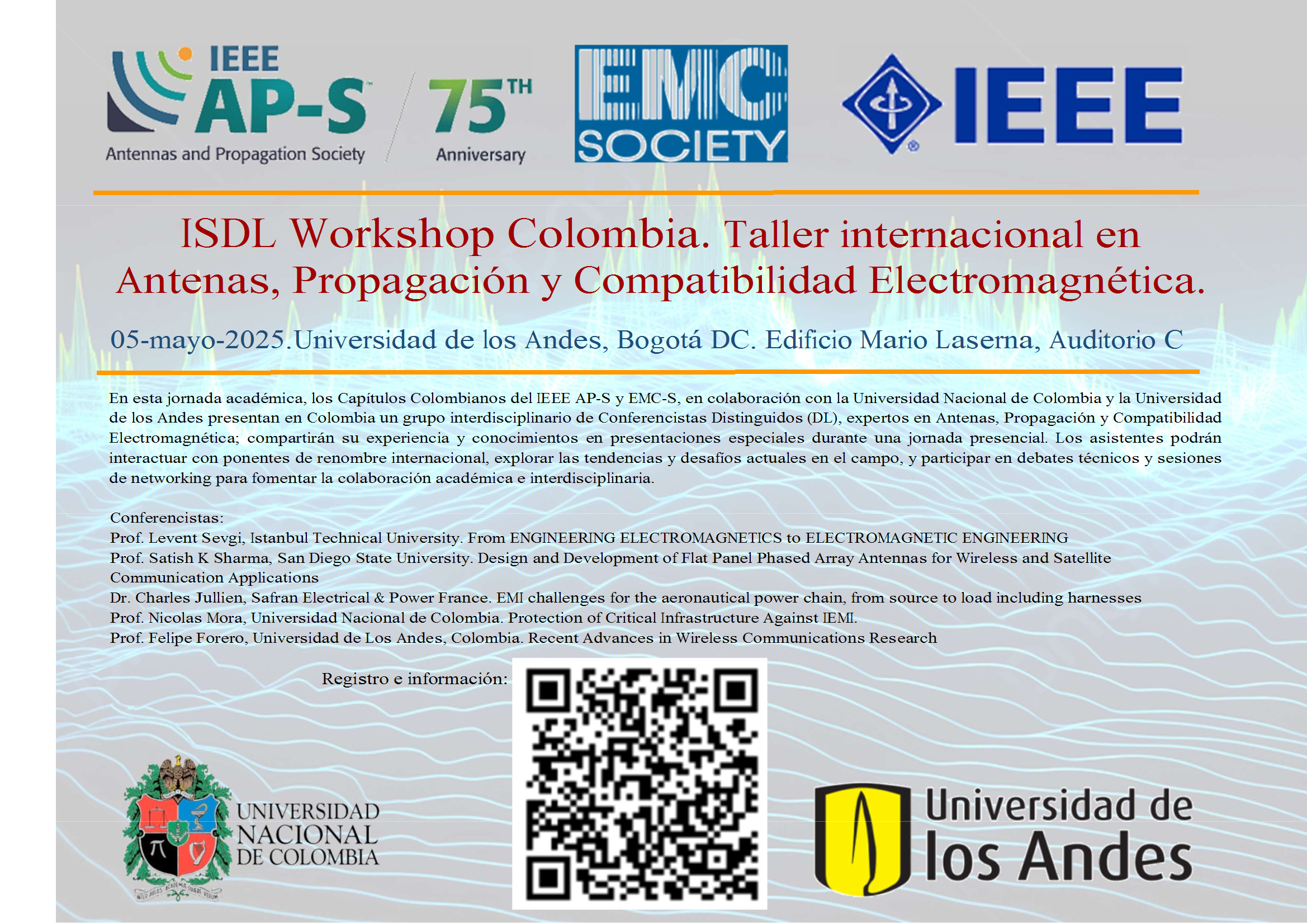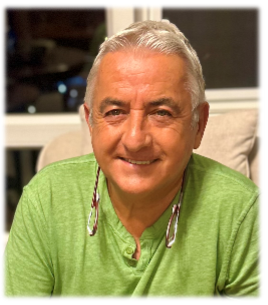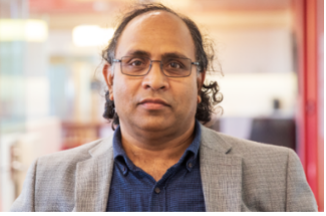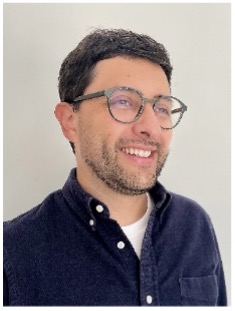ISDL Workshop Colombia
The IEEE AP-S and EMC-S Colombian Chapters, in collaboration with Universidad Nacional de Colombia and Universidad de los Andes, are pleased to present an Inter-Society Distinguished Lecture Workshop in Bogotá, Colombia. This one-day event will bring together leading experts in Antennas & Propagation and Electromagnetic Compatibility to share their insights through distinguished lectures. Attendees will be able to engage with internationally recognized speakers, explore current trends and challenges in the field, and participate in technical discussions and networking sessions designed to foster collaboration across disciplines.
Date and Time
Location
Hosts
Registration
-
 Add Event to Calendar
Add Event to Calendar
- Cra 1 E #19a-70, Bogotá
- Bogotá, Distrito Capital de Bogota
- Colombia
- Building: Universidad de los Andes, Edificio Mario Laserna
- Room Number: Auditorio C
- Click here for Map
- Contact Event Hosts
- Co-sponsored by Universidad Nacional de Colombia / Los Andes University
Speakers
Prof. Levent Sevgi of Istanbul Technical University
From ENGINEERING ELECTROMAGNETICS to ELECTROMAGNETIC ENGINEERING
The role of Electromagnetic (EM) fields in our lives has been increasing. Communication, remote sensing, integrated command/ control/surveillance systems, intelligent transportation systems, medicine, environment, education, marketing, and defense are only a few areas where EM fields have critical importance. We have witnessed the transformation from Engineering Electromagnetics to Electromagnetic Engineering for the last few decades after being surrounded by EM waves everywhere. Among many others, EM engineering deals with broad range of problems from antenna design to EM scattering, indoor–outdoor radiowave propagation to wireless communication, radar systems to integrated surveillance, subsurface imaging to novel materials, EM compatibility to nano-systems, electroacoustic devices to electro-optical systems, etc. The range of the devices we use in our daily life has extended from DC up to Terahertz frequencies. We have had both large-scale (kilometers-wide) and small-scale (nanometers) EM systems. A large portion of these systems are broadband and digital and must operate in close proximity that results in severe EM interference problems. Engineers must take EM issues into account from the earliest possible design stages. This necessitates establishing an intelligent balance between strong mathematical background (theory), engineering experience (practice), and modeling and numerical computations (simulation).
This Distinguished/keynote lecture aims at a broad-brush look at current complex EM problems as well as certain teaching / training challenges that confront wave-oriented EM engineering in the 21st century, in a complex computer and technology-driven world with rapidly shifting societal and technical priorities.
Biography:
Prof. Dr. LeventSevgi is aFellow of the IEEE (since 2009) and the recipient of IEEE APS Chen-To Tai Distinguished Educator Award (2021). He was with Istanbul Technical University (1991–1998), TUBITAK-MRC, Information Technologies Research Institute (1999–2000), Weber Research Institute / NY Polytechnic University (1988–1990), Scientific Research Group of Raytheon Systems Canada (1998 – 1999), Center for Defense Studies, ITUV-SAM (1993 –1998 and 2000–2002) and with University of Massachusetts, Lowell (UML) MA/USA as a full-time faculty (2012 – 2013), DOGUS University (2001-2014), Istanbul OKAN (2014 - 2021), and ATLAS (2022-2024) Universities.
He served four years (2020-2023) as an IEEE AP-S Distinguished Lecturer. Since Jan 2024 he has been the chair of the IEEE AP-S DL Committee. He served one-term in the IEEE AP-S AdCom (2013-2015) and one-term and as a member of IEEE AP-S Field Award Committee (2018-2019). He had been the writer/editor of the “Testing ourselves” Column in the IEEE AP Magazine (2007-2021), a member of the IEEE AP-S Education Committee (2006-2021), He also served in several editorial boards (EB) of other prestigious journals / magazines, such as the IEEE AP Magazine (2007-2021), Wiley’s International Journal of RFMiCAE (2002-2018), and the IEEE Access (2017-2019 and 2020 - 2022). He is the founding chair of the EMC TURKIYE International Conferences (www.emcturkiye.org).
He has been involved with complex electromagnetic problems for nearly four decades. His research study has focused on electromagnetic radiation, propagation, scattering and diffraction; RCS prediction and reduction; EMC/EMI modelling, simulation, tests and measurements; multi-sensor integrated wide area surveillance systems; surface wave HF radars; analytical and numerical methods in electromagnetics; FDTD, TLM, FEM, SSPE, and MoM techniques and their applications; bio-electromagnetics. He is also interested in novel approaches in engineering education, teaching electromagnetics via virtual tools. He also teaches popular science lectures such as Science, Technology and Society.
He has published many books / book chapters in English and Turkish, over 180 journal/magazine papers / tutorials and attended more than 100 international conferences / symposiums. His three books Complex Electromagnetic Problems and Numerical Simulation Approaches, Electromagnetic Modeling and Simulation and Radiowave Propagation and Parabolic Equation Modeling were published by the IEEE Press - WILEY in 2003, 2014, and 2017, respectively. His fourth and fifth books, A Practical Guide to EMC Engineering (Sep 2017) and Diffraction Modeling and Simulation with MATLAB (Feb 2021) were published by ARTECH HOUSE.
His h-index is 38, with a record of 5200+ citations (source: Google Scholar, Feb 2025).
Address:Türkiye
Prof. Satish K Sharma of San Diego State University
Design and Development of Flat Panel Phased Array Antennas for Wireless and Satellite Communication Applications
There is a great demand for high data throughput, innovative beam steering antenna solutions for wireless and satellite communication applications. In the last decade, beam steering antennas have seen tremendous progress, primarily due to the maturity of silicon beamforming chipsets, multilayer printed circuit boards, and 3D printing technologies. This talk will focus on the emerging flat panel phased array antennas used in wireless and satellite communications. The presentation will delve into electronic beam steering through beam forming networks and commercially available beam forming integrated circuit (BFIC) chips. Examples of X-/Ku-/Ka-band flat panel phased array antennas featuring dual linear, dual circular, and polarization reconfigurable designs will be showcased. The challenges and roles of silicon BFICs, multilayered printed circuit board (PCB) fabrication, RF component assembly, beam forming algorithms, and 3D dielectric and metal printing in antenna array designs will be explored during these discussions. The talk will emphasize the importance of data throughput testing of Ka-band flat panel phased array antennas in a laboratory environment and over-the-air (OTA) testing across a 1 km link between two San Diego State University buildings. It will also cover data throughput testing of a dual circular polarized Ka-band flat panel phased array on a payload over a 100,000 ft Aerostar balloon. The speaker will conclude with insights on the future evolution of beam steering technology.
Biography:
Dr. Satish Kumar Sharma, IEEE Fellow, received his Ph. D. degree in Electronics Engineering from the Indian Institute of Technology (IIT), Banaras Hindu University (BHU), India, in August 1997. He received his Bachelor of Technology in Electronics Engineering from Kamla Nehru Institute of Technology, India 1991. He was a Post-Doctoral Fellow at the University of Manitoba, Canada, from March 1999 to May 2001. He joined InfoMagnetics Technologies (IMT) Corporation, Winnipeg, Canada, as a Senior Antenna Engineer from May 2001 to August 2006. While at IMT, he was also a Part-Time Research Associate at the University of Manitoba until August 2006. Dr. Sharma joined San Diego State University (SDSU) as an Assistant Professor in August 2006. He established the Antenna and Microwave Laboratory (AML) shortly after joining SDSU and has led the AML as its Director since then. He became a tenured Associate Professor in August 2010. He was promoted to full Professor in August 2014 and currently holds this position. He received the National Science Foundation (NSF)’s prestigious faculty early career development (CAREER) award 2009. He also received the 2015 IEEE AP-S Harold A. Wheeler Prize Paper Award. He was Associate Editor of the IEEE Transactions on Antennas & Propagation and IEEE Antennas, Wireless & Propagation Letters. He is an IEEE AP-S Distinguished Lecturer (2025-2027), IEEE AP-S AdCom member (2025-2027), and the 2025 inaugural Chair of the Technical Committee on Security (TC9): Security, Defense, Disaster Management. His research lab can analyze, design, develop, and verify antennas from VHF to millimeter wave (110 GHz) frequencies. He has advised and mentored more than 110 undergraduate/graduate students and Post-Doctoral Fellows/visiting research scholars.
Dr. Sharma has published over 335 journal and conference papers and holds three US and Canadian patents. He co-edited three volumes of “Handbook of Reflector Antennas and Feed Systems”, published by Artech House in May/June 2013. His other co-authored book, “Multifunctional Antennas and Arrays for Wireless Communication Systems”, was published by IEEE-Press/Wiley in April 2021. He has collaborated with industry professionals on SBIR/STTR Phase I and II projects funded by DARPA, SPAWAR, Missile Defense Agency, and the Air Force Research Lab (AFRL) in addition to projects from the NSF and Office of Naval Research (ONR). He has also served as an engineer/consultant for several wireless and defense companies. He is also the CEO/founder of 5GAntennaTech, LLC. His research interests include microwave and millimeter-wave frequencies, beam steering antennas, flat panel phased array antennas, reconfigurable and tunable antennas, 3D printed antennas, inkjet printed conformal antennas, massive MIMO antennas, antennas for Cube-Satellites, reflector antennas and their feed systems, and metasurface antennas. His h-index is 37, i10-index is 109, with a record of 6200+ citations (source: Google Scholar, March 2025).
Address:United States
Dr. Charles Jullien of Safran Electrical & Power
EMI challenges for the aeronautical power chain, from source to load including harnesses
Biography:
Charles Jullien (IEEE SM’19) was born in 1985, in Rodez, France. He received the Master’s Degree in computational physics from Université des Sciences de Montpellier and the Ph.D. degree in electronics and telecommunication from the Institut d’Electronique et de Telecommunications de Rennes in 2013. Since November 2012, he is currently with Safran Electrical & Power, Blagnac, France. He is working in the EMC team of Design Office of ISE Division and, since 2024, he is currently EMC senior expert in electrical harness. His research interest includes modeling and measurement electromagnetic coupling in aeronautical harness and over shielding harnesses. He is also since 2021 secretary of the French chapter of IEEE EMC.
Address:France
Prof. Nicolas Mora of Universidad Nacional de Colombia
Protection of Critical Infrastructure Against IEMI
The progress of high-power electromagnetic (HPEM) sources during the late 1990s raised concern in the EMC community that they could be deployed for criminal purposes to interfere with the operation of modern electronic systems. It is well established that sufficiently intense electromagnetic fields can cause upset or damage in electronic systems and, therefore, can affect almost every critical infrastructure (CI) based on information and communication technologies (ICT).
Protection against Intentional Electromagnetic Interference (IEMI) threats can be acknowledged as reminiscent of the cold war period and the research programs on protection against high-altitude electromaganetic pulse (HEMP). This talk reviews the assessment techniques of the vulnerability of CI against IEMI. To quantify their impact, the IEMI environments need to be charac- terized, the susceptible components and subsystems of the CI should beidentified,andtheexpecteddisturbanceshavetobeevaluated.
Biography:
Nicolas Mora (M’07 - SM ‘18) received a B. S. degree in Electronics Engineering in 2007 and a M.Sc. degree in Electrical Engineering with a major in High Voltage Engineering in 2009, both from the Universidad Nacional de Colombia-UNAL (National University of Colombia) in Bogota. He joined the EMC Research Group of the UNAL in 2007. In 2009, he joined the EMC Lab at the Swiss Federal Institute of Technology (EPFL). He received his Ph. D degree in Electrical Engineering from EPFL in 2016. From 2015 to 2019, he worked as an R & D Engineer for Montena Technology. In 2020, he joined the Directed Energy Research Center of the Technology Innovation Institute in Abu Dhabi, where he was the Senior Director of Electromagnetic Effects. In 2023, he joined the Research and Extension Directorate of the UNAL Bogota. In 2024, he was appointed Assistant Professor in the Department of Electrical and Electronics Engineering, Universidad Nacional de Colombia in Bogota.
In 2011, he received the Frank Gunther Award from the Radio Club of America and the Young Scientist Award from URSI. From 2013-2016, he was the president of the Colombian Association of Researchers in Switzerland. In 2015, he received the Young Scientist Award from the Summa Foundation. He was appointed Distinguished Reviewer of the IEEE Transactions on Electromagnetic Compatibility in 2015, 2016, 2018, 2019, and 2020. He was the chair of the joint EMC / AP / MTT chapter of IEEE in Switzerland between 2016 and 2019. In 2016 he received the Best Paper Award from the EMC Europe 2016 Wroclaw Symposium. In 2018, he received the HPEM Fellow award from the Summa Foundation, and in 2019, the Motohisa Kanda Most Cited IEEE Transactions in EMC Paper Award. Since 2021, he has been Associate Editor of the IEEE Letters on Electromagnetic Compatibility Practice and Application. Since 2022, he has been an Associate Editor of the IEEE Transactions on Electromagnetic Compatibility. He was elected IEEE EMC Distinguished Lecturer for the period 2022-2023. In 2023, he joined the Board of Governors of the IEEE EMC Society as a representative of R9.
Address:Colombia
Prof. Felipe Forero of Los Andes University
Recent Advances in Wireless Communications Research at Los Andes University
Biography:
Felipe Forero received the B.Sc. and M.Sc. degrees in electronic engineering from Universidad Distrital Francisco José de Caldas, Bogotá, Colombia. He received the Ph.D. degree in Engineering from Universidad de los Andes, Bogotá, Colombia, and a Ph.D. degree in Computer Science from the University of Campinas (UNICAMP), Campinas, Brazil. He is currently an Assistant Professor of the Electrical and Electronic Engineering Department at los Andes University. His research interests include performance modeling of Ad Hoc networks, complex graph analysis applied to critical infrastructure communication systems, low-complexity algorithm design for reconfigurable intelligent surfaces (RIS), and electromagnetic simulation of superstructures.
Address:Colombia
Agenda
Program
| Time | Speaker | Affiliation | Lecture Title |
| 8:00 | Registration | ||
| 8:30 | Opening Words | ||
| 9:00 | Prof. Levent Sevgi | Istanbul Technical University, Turkiye | From ENGINEERING ELECTROMAGNETICS to ELECTROMAGNETIC ENGINEERING |
| 10:00 | Morning Break | ||
| 10:30 | Dr. Charles Jullien | Safran Electrical & Power, France | EMI challenges for the aeronautical power chain, from source to load including harnesses |
| 11:30 | Prof. Felipe Forero | Los Andes University, Colombia | Recent Advances in Wireless Communications Research at Los Andes University |
| 12:30 | Lunch Break | ||
| 14:00 | Prof. Satish K Sharma | San Diego State University, USA | Design and Development of Flat Panel Phased Array Antennas for Wireless and Satellite Communication Applications |
| 15:00 | Afternoon Break | ||
| 15:30 | Prof. Nicolas Mora | Universidad Nacional de Colombia, Colombia | Protection of Critical Infrastructure Against IEMI |
| 16:30 | Closing Remarks | ||
*Catering will be served during the morning, lunch, and afternoon breaks at no cost







